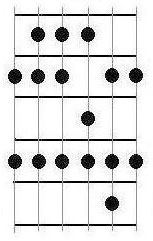Mixolydian Mode

Mixolydian mode chart diagram
Mixolydian mode may refer to one of three things: the name applied to one of the ancient Greek harmoniai or tonoi, based on a particular octave species or scale; one of the medieval church modes; a modern musical mode or diatonic scale, related to the medieval mode.
Greek Mixolydian
The idea of a Mixolydian mode comes from the music theory of ancient Greece. The ancient Greek Mixolydian mode was invented by Sappho, the 7th century B.C. poet and musician.[1] However, what the ancient Greeks thought of as Mixolydian was very different from the modern interpretation of the mode.
In Greek theory, the Mixolydian mode (or tonos) employs a scale (or 'octave species') corresponding to the Greek Hypolydian mode inverted: in its diatonic genus, this is a scale descending from paramese to hypate hypaton: in the diatonic genus, a whole tone (paramese to mese) followed by two conjunct inverted Lydian tetrachords (each being two whole tones followed by a semitone descending). This is the equivalent of playing all the 'white notes' of a piano from B to B, or B | A G F E | (E) D C B, which is also known as a modern locrian mode. (In the chromatic and enharmonic genera, each tetrachord consists of a minor third plus two semitones, and a major third plus two quarter-tones, respectively).[2]
Medieval Mixolydian and Hypomixolydian
Medieval European music scholars understood the Greek system of modes through the Latin works of Boethius. However, his work was misinterpreted,[vague] and the name Mixolydian came to be applied to one of the eight modes of medieval church music: the seventh mode. This mode does not run from B to B on white notes, as the Greek mode, but was defined in two ways: as the diatonic octave species from G up one octave to the G above, or as a mode whose final was G and whose ambitus runs from the F below the final to the G above, with possible extensions "by licence" up to A above and even down to E below, and in which the note D (the tenor of the corresponding seventh psalm tone) had an important melodic function.[3] This misinterpretation led to the current use of the term for the natural scale from G to G.
The seventh mode of western church music is an authentic mode based on and encompassing the natural scale from G to G, with the perfect fifth (the D in a G to G scale) as the dominant, reciting note or tenor.
The plagal eighth mode was termed Hypomixolydian (or "lower Mixolydian") and, like the Mixolydian, was defined in two ways: as the diatonic octave species from D to the D an octave higher, divided at the mode final, G (thus D–E–F–G + G–A–B–C–D); or as a mode with a final of G and an ambitus from C below the final to E above it, in which the note C (the tenor of the corresponding eighth psalm tone) had an important melodic function.[4]
This modern scale has the same series of tones and semitones as the major scale, except the seventh degree is a semitone lower.[5]
The order of tones and semitones in a Mixolydian scale is TTSTTST (T = tone; S = semitone), while the major scale is TTSTTTS. The key signature varies accordingly (it will be the same as that of the major key a fifth below).[5]
The G Mixolydian mode (Related to the key of C major - on a piano it is all the white keys from one G to the next. GABCDEFG)[5]
The C Mixolydian mode (Related to the key of F major. CDEFGAB♭C)[5]
The D Mixolydian mode (Related to the key of G major. DEF♯GABCD)[5]
The E Mixolydian mode (Related to the key of A major. EF♯G♯ABC♯DE)[5]
